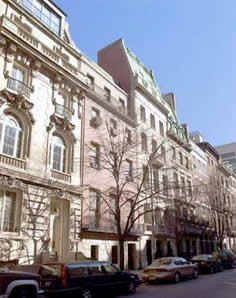
 |
||||||




|
Design guidelines provide |
<--Excerpt from the "Benefits of Design Review" by Nore Winter from the Alliance Review, July/August 2001. |
Local review of work proposals.
In the design review process, owners of locally designated landmarks and
districts must get approval from a locally appointed historic preservation
commission or architectural review board for major exterior alterations,
additions, and new construction. Commission approval is in the form of
a "certificate of appropriateness." To be approved, an application
for must meet the design review criteria within the preservation ordinance
that a community has adopted. Both the terminology and process may vary
somewhat, depending upon the ordinance.
| Example of a local preservation ordinance | |
|
Fairfax County, Virginia >> FAIRFAX COUNTY ZONING ORDINANCE [PDF*], 7-204, Administration of Historic Overlay District Regulations, pp. 7-10 to 7-16. |
|
| Example of an illustrated local design guideline | |
| Raleigh,
North Carolina >> RALEIGH HISTORIC DISTRICTS COMMISSION [PDF*], Section 4, Additions and New Construction, pp. 51-58. |
|
| *Requires Adobe Acrobat Reader |
Clarifying the role of the guidelines.
The topic of local design guidelines always needs to be understood
within its relationship to the local preservation ordinance. The ordinance
is a law and the design review criteria are part of the law. Design guidelines
are not, in and of themselves, mandatory like the ordinance and should
not be confused with the ordinance. In most cases, guidelines are just
that—helpful, interpretive, explanatory recommendations. Consisting
of written and graphic information in a printed, book format, they are
key support materials for administering design review and may be used
to advantage by commissions, boards, and applicants alike in the review
process.
How districts variously use the Secretary's
Standards.
The philosophical principles in The Secretary of Interior's
Standards for the Treatment of Historic Properties have been proven
to be important in the successful administration of historic districts.
Sometimes they are cited within a preservation ordinance as part of the
design review criteria. Sometimes they are referenced in the ordinance
as the required basis for development of a local design guideline. While
some preservation ordinances state that design guidelines "shall
be adopted," others state that design guidelines "may be adopted."
A few districts may use the Standards for Rehabilitation by themselves—as
a general guideline—without creating a specific local design guideline.
It can be confusing. The ordinance can remove confusion by specifying
which categories of information must be used (e.g., review criteria) and
which are only advisory (e.g., guidelines).
Please
note if you plan to apply for Federal income tax incentives for historic preservation: Following a local ordinance and local design guidelines--especially if the goal in your historic district is to "restore" historic buildings to an earlier appearance--may be in conflict with the federal "Secretary of the Interior's Standards for
Rehabilitation" (36 CFR 67) used to review federal tax credit applications. The expressed goal of rehabilitation is to update historic buildings for continuing and new uses while preserving character-defining features. Be sure to ask your State Historic Preservation Office for guidance early in the planning stages of any Federal income tax incentives project.
NOTE: Print all of Section 'c' in PDF format.
---------------------------------
 A basis for making
fair decisions
A basis for making
fair decisions